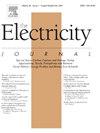Practical energy equity decision making in resource-constrained communities: A case study in the Navajo Nation
IF 2.2
Q1 Social Sciences
引用次数: 0
Abstract
There is an increasing recognition of the central role of energy equity and social justice in energy planning. Governments, utilities, planners, and the research community are working to advance a more nuanced understanding of energy equity, involving distributive, procedural, recognitional, and restorative aspects. Complete energy equity requires a holistic understanding of all these aspects, and energy planning should attempt to address them simultaneously. In practice, this can be challenging in contexts where the available pool of human and economic resources is limited. This article presents a case study of a community within the Navajo Nation to illustrate the challenges and implications in such contexts. The first challenge is the inevitable prioritization and compartmentalization of decision making due to the constraints imposed by the planners’ primary mandates, authority, place-based contextual factors, and available resources. The second – related – challenge is the impact of the resulting decisions on realized outcomes, and its effects on the community perceptions of – and confidence in – the planning institutions. The case study also finds that equity concerns of the utility’s end-customers may not always be uniform and are influenced by the customers’ perspectives, roles, responsibilities, and expectations. Thus, a more holistic view of energy planning is necessary to 1) capture the variations of equity opinions and priorities across all stakeholders, 2) to ensure that decisions and resource allocations by utilities, elected bodies, or governmental agencies occur on multiple fronts in a coordinated and transparent manner to advance energy equity targets.
资源受限社区的实际能源公平决策:以纳瓦霍族为例
人们日益认识到能源公平和社会正义在能源规划中的中心作用。政府、公用事业、规划者和研究界正在努力推动对能源公平的更细致的理解,包括分配、程序、认识和恢复等方面。完全的能源公平需要对所有这些方面有全面的了解,而能源规划应试图同时解决这些问题。实际上,在现有人力和经济资源有限的情况下,这可能具有挑战性。本文提出了一个纳瓦霍族社区的案例研究,以说明在这种情况下的挑战和影响。第一个挑战是由于规划者的主要任务、权威、基于地点的环境因素和可用资源所施加的限制,不可避免地对决策进行优先排序和划分。第二个相关的挑战是由此产生的决策对实现结果的影响,以及它对社区对规划机构的看法和信心的影响。案例研究还发现,公用事业的最终客户的公平问题可能并不总是一致的,并受到客户的观点、角色、责任和期望的影响。因此,有必要对能源规划有一个更全面的看法,以1)捕捉所有利益相关者的公平意见和优先事项的变化,2)确保公用事业、民选机构或政府机构的决策和资源分配以协调和透明的方式在多个方面进行,以推进能源公平目标。
本文章由计算机程序翻译,如有差异,请以英文原文为准。
求助全文
约1分钟内获得全文
求助全文
来源期刊

Electricity Journal
Business, Management and Accounting-Business and International Management
CiteScore
5.80
自引率
0.00%
发文量
95
审稿时长
31 days
期刊介绍:
The Electricity Journal is the leading journal in electric power policy. The journal deals primarily with fuel diversity and the energy mix needed for optimal energy market performance, and therefore covers the full spectrum of energy, from coal, nuclear, natural gas and oil, to renewable energy sources including hydro, solar, geothermal and wind power. Recently, the journal has been publishing in emerging areas including energy storage, microgrid strategies, dynamic pricing, cyber security, climate change, cap and trade, distributed generation, net metering, transmission and generation market dynamics. The Electricity Journal aims to bring together the most thoughtful and influential thinkers globally from across industry, practitioners, government, policymakers and academia. The Editorial Advisory Board is comprised of electric industry thought leaders who have served as regulators, consultants, litigators, and market advocates. Their collective experience helps ensure that the most relevant and thought-provoking issues are presented to our readers, and helps navigate the emerging shape and design of the electricity/energy industry.
 求助内容:
求助内容: 应助结果提醒方式:
应助结果提醒方式:


